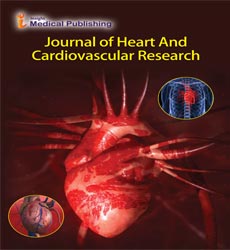ISSN : ISSN: 2576-1455
Journal of Heart and Cardiovascular Research
Cardiovascular Implications of Exercise Intolerance in HFpEF: Ventricular Dysfunction and Pulmonary Complications
Dalane Patrice*
Department of Cardiovascular Research, Georgia State University, Georgia, USA
- *Corresponding Author:
- Dalane Patrice
Department of Cardiovascular Research, Georgia State University, Georgia,
USA,
E-mail: dalanep@yahoo.com
Received date: May 07, 2024, Manuscript No. IPJHCR-24-19368; Editor assigned date: May 10, 2024, PreQC No. IPJHCR-24-19368 (PQ); Reviewed date: May 27, 2024, QC No. IPJHCR-24-19368; Revised date: June 03, 2024, Manuscript No. IPJHCR-24-19368 (R); Published date: June 10, 2024, DOI: 10.36648/2576-1455.8.2.69
Citation: Patrice D (2024) Cardiovascular Implications of Exercise Intolerance in HFpEF: Ventricular Dysfunction and Pulmonary Complications. J Heart Cardiovasc Res Vol.8 No.2: 69.
Description
Heart Failure with Preserved Ejection Fraction (HFpEF) is indeed a challenging condition. It's characterized by the heart's inability to pump blood effectively despite having a normal ejection fraction. The symptoms, such as severe exertional dyspnea and debilitating fatigue, significantly impact patients quality of life and often lead to frequent hospitalizations and high mortality rates. Affected patients often experience severe exertional dyspnea and debilitating fatigue, as well as poor quality of life, frequent hospitalizations and high mortality. Most pharmacological intervention studies in Heart Failure with preserved Ejection Fraction (HFpEF) produced neutral primary results.
Pharmacological studies
In differentiate, trials of exercise-based intercessions have reliably appeared huge, critical and clinically imperative changes in side effects, impartially characterized work out capacity and in general quality of life. This success may be due, at least in part, to the pleiotropic effects of exercise, which can favorably influence all abnormalities-peripheral vasculature, skeletal muscle and cardiovascular-that contribute to exercise intolerance in HFpEF. Therefore, this scientific opinion critically reviews the currently available literature on the effects of exercise-based therapies in chronic stable HFpEF, the possible mechanisms of improvement in exercise capacity and symptoms and how these data compare with exercise therapy in other cardiovascular diseases. Specifically, the data reviewed here show comparable or greater improvements in exercise capacity in patients with chronic HFpEF with controlled exercise compared with patients with reduced ejection fraction HF, although medical reimbursement is only available for the latter group. Finally, critical gaps in the implementation of exercise-based therapies in patients with HFpEF, including exercise, exercise methods, combinations with other strategies such as diet and medication, long-term compliance, inclusion of innovative and more accessible delivery methods and treatment management. Recently hospitalized patients are highlighted to provide guidance for future research. Several exercise-based therapy trials have been conducted in patients with chronic heart failure and HFpEF. Unlike pharmacological studies, most report positive primary results with relatively large, clinically significant effects. Pharmacological studies have focused on clinical outcomes, whereas smaller exercise studies have focused primarily on aerobic exercise capacity and quality of life and none have been adequately powered for events. However, exercise capacity i.e., cardiorespiratory fitness is an independent, clinically important patient outcome and its measurement is valid, objective and reproducible.
Vascular remodeling
This positive information on work out resilience in patients with incessant HFpEF provoked the current American Heart Association (AHA) which depicts the measurement and basic components of exercise intolerance and critically reviews the currently available data on exercise-based therapies and dicusses the reasons for their promotion and wider distribution. Decreased cardiac output during exercise is due to a modest blunting of stroke volume growth and chronotropic incompetence, which occurs in up to 50% of patients with HFpEF. Stroke volume decreases despite an excessive increase in inflation pressure during exercise. Left ventricular systolic and diastolic dysfunction and left atrial dysfunction can also impair exercise tolerance. Chronically elevated left ventricular filling pressure leads to pulmonary vascular remodeling and impaired gas exchange, as well as impaired pulmonary diffusion and alveolar ventilation. Pulmonary hypertension occurs in >50% of patients with HFpEF right ventricular dysfunction is observed in about a third of patients and both may contribute to exercise intolerance and poor prognosis.
Open Access Journals
- Aquaculture & Veterinary Science
- Chemistry & Chemical Sciences
- Clinical Sciences
- Engineering
- General Science
- Genetics & Molecular Biology
- Health Care & Nursing
- Immunology & Microbiology
- Materials Science
- Mathematics & Physics
- Medical Sciences
- Neurology & Psychiatry
- Oncology & Cancer Science
- Pharmaceutical Sciences
